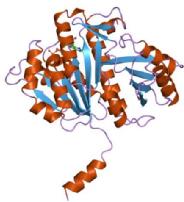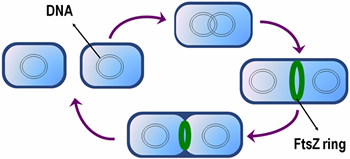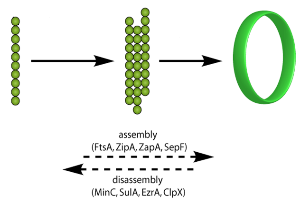Current Research
Why FtsZ
1) In bacterial, FtsZ polymerize into a ring structure (Z-ring) to play an important role in the contol of cell division.
2) FtsZ is a highly conserved protein, which can be found almost in all bacteria.
3) Structural and functional similarity show that FtsZ is a homologue of tublin, and even could be the evolutionary precursor to tubulin and microtubules.
4) FtsZ could be the target of cell division inhibitors, which can help the development a new class of antibiotics.
FtsZ in bacterial cell division
The earliest event in bacterial cytokinesis is the localization of FtsZ to the future division site, where it assembles into a ring-like structure called Z-ring. The ring then reduces in diameter during cell division, drawing the cytoplasmic membrane inwards. This constriction of the ring gives rise to two equal daughter cells.
A typical cell cycle in E. coli
As a GTPase, FtsZ is capable of GTP-induced self-assembly into higher-order polymers. These polymers exhibit dynamic behavior, which depends on the ability of FtsZ to hydrolyze its bound GTP. However, a number of accessory proteins are recruited to Z-ring by either direct or indirect interaction with FtsZ to constitute the cytokinetic machinery. These accessory proteins can be conveniently grouped into supporters (ZipA, ZapA) or inhibitors (MinC, SulA, EzrA) of FtsZ polymerization.
FtsZ assembly and disassembly
The focus in my work
Since it seems increasingly likely that the formation of bundles through lateral interactions between FtsZ polymers is critical to the function of the Z-ring, I am interested in studying the promoters of FtsZ polymerization. What I am exploring is YgfE, the putative ZapA orthologue in E. coli, with the purpose to know how it interacts with FtsZ and promote polymer association. Particularly, I use linear dichroism (LD) to monitor changes in the FtsZ polymer.
References:
1. Adams, D.W. & Errington, J. Bacterial cell division: assembly, maintenance and disassembly of the Z ring. Nat. Rev. Micro. (2009) 7: 642-653.
2. Margolin W. FtsZ and the division of prokaryotic cells and organelles. Nat. Rev. Mol. Cell Bio. (2005) 6: 862-871.
3. Small, E. et al. FtsZ polymer-bundling by the Escherichia coli ZapA orthologue, YgfE, involves a conformational change in bound GTP. J. Mol. Biol. (2007) 369: 210-221.
4. Gueiros-Filho, F.J. & Losick, R. A widely conserved bacterial cell division protein that promotes assembly of the tubulin-like protein FtsZ. Genes & Dev. (2002) 16: 2544-2556.

Crystal structure of FtsZ (PDB code: 1fsz)


